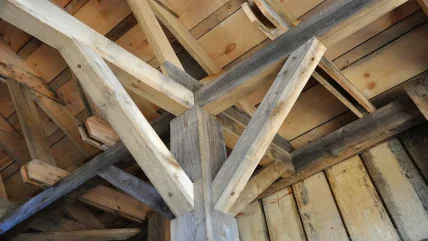
After record product prices, revenue, and profitability in 2021 for the North American OSB industry, 2022 started off strong.
In aggregate, 2022 industry performance was the second best in history after 2021. However, mortgage interest rates steadily rose, housing purchase activity slowed down, and OSB prices fell during 2022. Prices and profitability at the end of 2022 were much lower than at the beginning of the year.
In an effort to reverse unexpectedly high inflation, the Federal Reserve Bank raised the reference interest rate by 4.25% during 2022.
Mortgage interest rates doubled from about 3% at the beginning of the year to more than 6% at the end of 2022. The combination of higher mortgage rates and recent house price increases reduced North American housing affordability, residential construction, and OSB usage in the second half of 2022.
For three publicly-traded forest products manufacturers (Louisiana Pacific, West Fraser, Weyerhaeuser), 2022 financial results for their OSB divisions mirrored the declining demand and falling prices. Fourth quarter 2022 net sales and average product prices for OSB fell by 60% and dollar profits declined by 90% compared to Q1 2022.
The economic case for more OSB manufacturing capacity has weakened, but significant additional capacity is scheduled to come online before early 2024. While Huber cancelled its planned greenfield facility, Roy O Martin and West Fraser are each scheduled to open a modern new mill within the next year. Additionally, Tolko continues to rebuild the High Prairie mill in Alberta destroyed by fire in May, 2022. Dieffenbacher is supplying the core components for the project, which is expected to be complete by the end of 2023 and will see the facility have a production capacity of 734,000m3 of OSB per year.
Given expectations for weak housing starts plus additional capacity starting up, it’s unlikely that OSB prices will soon return to the lucrative levels of mid-2020 through mid-2022. Medium-term industry profitability will reflect the mediocre prices.
DECLINING HOUSING AFFORDABILITY REVERSES MOMENTUM
A collateral consequence of recent high inflation is that the Federal Reserve Bank and the Bank of Canada (as well as most other central banks) substantially raised reference interest rates. The Federal Funds Target Rate and the Canadian Target Overnight Rate both rose from 0.00% in January 2022 to 4.25% in December. Mortgage interest rates have trended upward as reference rates increased.
A US homeowner conventionally purchases a dwelling with a 30-year fixed rate mortgage that requires a 20% down payment. In Q4, 2019 immediately prior to the pandemic, the government owned secondary mortgage bank Freddie Mac calculated the average 30-year fixed rate mortgage at about 3.7%. The mortgage rate average fell to 2.7% by the end of 2020 as the Fed increased money supply during the initial pandemic panic; those lower rates stimulated purchases of new and existing houses.
However, the pandemic economic stimulus caused inflation to rise, starting in 2021. Central banks have repeatedly raised interest rates to bring down inflation. At the end of 2022 the average mortgage interest rate exceeded 6.5% versus 3% at the end of 2021.
The apparently small increase in mortgage interest rates, a steady upsurge in average house cost, and slow wage growth has adversely reduced housing affordability. The median mortgage payment for a typical home purchase almost doubled from about US$1,420 per month at the end of 2019 to US$2,720 at the end of 2022. Since median household income only grew about 6% over the three years, the payment for an average newly originated mortgage consumes a much higher proportion of family income.
Total US residential construction starts for the first half of 2022 exceeded the same period of 2021. However, total housing starts of 1.6 million in 2021 declined to 1.55 million in 2022. Construction particularly fell in second half of 2022 as housing affordability declined.
The decline in residential construction entirely resulted from single-family units as the 545,000 multi-family units that started construction in 2022 exceeded the 475,000 units of 2021. Multi-family units were 35% of total 2022 starts compared to 30% in 2021. This changing proportion is relevant for OSB makers because multi-family units use onethird to one-half of the building materials of a single-family unit.
While less volatile than US trends because of tighter banking regulations, the Canadian housing market responds to parallel economic forces. Canadian housing starts of 271,000 in 2021 slightly decreased to 261,000 in 2022. Canada always has a higher proportion of multi-family units compared to the US, and multi-family increased to 72% of total residential starts in 2022 compared to 70% in 2021.
OSB PRICES FALL TO PRE-PANDEMIC LEVELS DURING Q2, 2022
Most North American OSB is used for construction, instead of as an industrial raw material. Prices and demand for OSB correlate with construction activity; demand and prices go up when construction activity increases and vice versa. The pandemic housing construction boom lasted from summer 2020 to the middle of 2022, and OSB prices were extraordinarily high over those two years.
OSB prices briefly reached a new record during 2022, after breaking records in 2020 and 2021. According to Random Lengths, the March 2022 price of US$1,235/m3 for benchmark south-eastern US 7/16in (approximately 11mm) OSB exceeded the prior June 2021 record of US$1,125/m3.
However, the year ended much worse than it began. 2022 started at US$600/m3, peaked in March, and ended the year at US$200/m3 as housing construction activity ebbed. The December 2022 minimum fell below the typical pre-pandemic price of about US$215/m3.
North American OSB production almost equals North American OSB usage, with Canada a net supplier to the US. Total 2022 shipments, as measured by volume, from Canada to the US increased by 2% compared to 2021. However, shipment volumes weakened in the second half of the year as prices declined. The total USD value of the Canadian shipments decreased by 20% due to lower prices.
Much of the relatively small volume of non-North American OSB originates in eastern Europe. While the US government has not banned trade in Belarussian and Russian agricultural commodities including wood products, OSB imports from Belarus and Russia substantially fell after approximately March 2022. Latvia and Romania are two other OSB sources, and for both first half volumes exceeded second half volumes.
WEAKER SECOND HALF OF 2022 FOR OSB MAKERS
The three publicly-traded forest products manufacturers that disclose an OSB segment enjoyed a strong 2022. Fiscal 2022 sales and profits for these publicly-traded OSB producers (collectively with 54% of North American production in 2022) were the second best in history after the record 2021.
Average sales return for all of 2022 was US$596/m3 compared to US$712/m3 in 2021, and mean EBITDA margin was 51% in 2022 versus 62% in 2021. However, these companies also report that OSB prices that had started 2022 near record highs fell to pre-pandemic levels by year end. While the average sales return for all of 2022 was US$596/m3, a near-record sales return of US$846/m3 (EBITDA margin = 67%) during Q1 fell to a US$364/m3 (EBITDA margin = 16%) average in Q4.
Two of the principal production costs for wood panels – adhesives and energy – are closely correlated with international energy prices. Crude oil and natural gas prices remained relatively low for more than a year after the pandemic started. Particularly since Russia’s invasion of Ukraine disrupted global energy markets, fossil fuel prices have increased. West Texas Intermediate crude oil started 2022 at US$75/barrel, peaked at US$114 in May, and ended the year at US$80.
The major ingredients – lye, methanol, and phenol – of phenol formaldehyde (PF) resin are petrochemical derivatives. The authors occasionally review invoices for PF resin, and 2022 costs were about 70-80% higher than the pre-pandemic price.
The Random Lengths newsletter reports that OSB market prices in February 2023 are within a few per cent of the pre-2020 norm. While OSB manufacturing survivors at least broke even at typical pre-pandemic prices, higher manufacturing costs may mean that some OSB makers are not profitable with market prices at the level of three years ago. Around the start of 2023, several producers reduced output through temporary curtailments, shift eliminations, and maintenance shutdowns.
OSB MILL CAPACITY PROJECTS
In 2021 when OSB prices were near historic highs, experienced operators announced additions of three modern mills. Huber announced a greenfield facility in Cohasset, Minnesota and Roy O Martin announced a second greenfield mill in Corrigan, Texas. West Fraser purchased a closed mill in Allendale, South Carolina previously operated by Georgia-Pacific. Each mill was anticipated to start production in 2023 or early 2024.
In May 2022, a fire in the multi-opening press destroyed much of Tolko’s OSB mill in High Prairie, Alberta. Tolko almost immediately announced it would rebuild a state-of-the-art mill.
In February 2023, Huber cancelled plans to build the Minnesota mill that would have been outfitted by Siempelkamp. Huber believed it could not overcome objections from neighbouring indigenous communities about the project’s environmental impact on ancestral lands in a timely manner. Huber now intends to build a greenfield OSB mill in another state, but has not announced a specific project.
The Roy O Martin project in Texas that is based around a Dieffenbacher continuous press has suffered delays, but the current start-up goal is late 2023 or early 2024. The major upgrades to the South Carolina mill are scheduled for completion before Q3, 2023; however, West Fraser has not announced a specific date to commence operations. Tolko’s goal is to reopen the Alberta mill in late 2023 after installing a Dieffenbacher continuous press.
Market demand doesn’t necessarily grow following new supply. The pattern of the North American forest products industry has been a boom-and-bust cycle in which lack of capacity discipline eventually ends the good times of high prices. Relatively inefficient older mills often close soon after efficient state-of-the-art facilities open.
PERFORMANCE IN 2023 TO REFLECT HOUSING MARKET DECLINE
Inflation pressures have lessened, and the Federal Reserve Bank has decelerated interest rate increases. Since peaking at more than 7% in November 2022, mortgage interest rates have moderated. In February 2023, the conventional 30-year fixed mortgage rate was about 6.3%. Wells Fargo, the fourth largest mortgage originator in the US, currently predicts that the mortgage rate will fall to 5.4% by the end of 2023.
However, the relatively high mortgage rates will keep monthly payments unaffordable for many prospective homeowners. After 1.6 million and 1.55 million housing starts in 2021 and 2022, respectively, APA – The Engineered Wood Association consensus housing start forecast predicts a much lower 1.27 million units in 2023. APA predicts Canadian housing starts of 265,000 in 2023, which is not far different from 2021 and 2022.
If 2023 housing starts match current predictions, OSB likely will remain close to pre-2020 prices. Additional OSB supply within the next 12 months will place downward pressure on market prices. At best 2023 could be modestly profitable for OSB makers.






